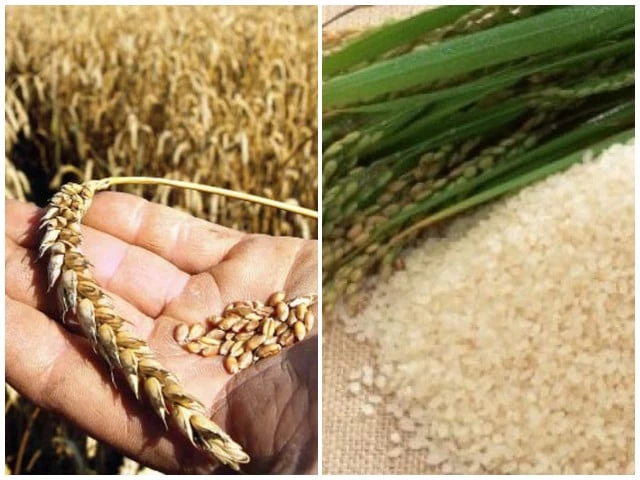ISLAMABAD:
The government has set a wheat production target of 29.68 million tonnes for the 2025-26 Rabi season.
The Federal Committee on Agriculture (FCA), headed by Federal Minister for National Food Security and Research Rana Tanveer Hussain, reviewed the performance of the 2025-26 Kharif crops and approved production targets for the upcoming Rabi crops.
The meeting was attended by provincial agriculture ministers, secretaries and senior officials from both federal and provincial departments.
The Ministry of National Food Safety and Research has proposed a wheat production target of 29.68 million tonnes over an area of 9.65 million hectares.
Production targets for gram, potato, onion and tomato have been set at 393, 8,916, 2,788 and 659 thousand tonnes respectively.
The ministry has also finalized the wheat policy to ensure that farmers receive reasonable support prices to cover production costs and earn a reasonable profit.
The minister said the policy reflects the government’s commitment to protect farmers’ interests and achieve self-sufficiency in staple food crops.
The committee also reviewed seed availability for Rabi crops. The Director General, Federal Seed Certification and Registration Department (FSC&RD), informed that the availability of certified seed for Rabi 2025-26 will continue to be satisfactory.
In terms of water availability, the IRSA Advisory Committee did not expect any shortage of water for Punjab and Sindh during Rabi 2025-26. The provinces have been allocated 33.814 million acre-feet (MAF) of water.
During the meeting, the committee was informed that sugarcane production for 2025-2026 is tentatively estimated at 84.7 million tonnes from an area of 1.146 million hectares, showing an increase of 5.5% in area and 5.9% in production over the targets set by the FCA.
Rice production for 2025-26 is estimated at 9.417 million tonnes from an area of 3.039 million hectares, indicating an increase of 21.9% in area and 2.7% in production over the set targets. Similarly, mungbean production for 2025-2026 is estimated at 150.8 thousand tons from an area of 170.6 thousand hectares, showing an increase of 22.9% in area and 1.2% in production compared to last year.
In line with the government’s agenda to promote the agriculture sector, Rana Tanveer Hussain appreciated the efforts of the State Bank of Pakistan to increase the flow of agricultural credit. SBP assigned an indicative farm credit disbursement target of Rs. 2572 billion for FY 2025, which was 16.3% higher than the previous year’s disbursement of Rs. 2250 billion Currently, 47 financial institutions provide agricultural credit to farmers, including 5 large commercial banks, 13 medium domestic private banks, 6 Islamic banks, 2 specialized banks (ZTBL & PPCBL), 11 microfinance banks and 10 MFIs/RSPs.
During the financial year 2025, the lending institutions disbursed Rs. 2577 billion, achieving 100.2% of the overall annual target and registering a growth of 16.3% as compared to Rs. 2215 billion paid out in the corresponding period last year. The committee was also informed that the supply of urea and DAP fertilizers is expected to remain stable in the coming Rabi season (November-December 2025).
Union Minister Rana Tanveer Hussain said the government under the leadership of the Prime Minister is fully committed to strengthening the agriculture sector, ensuring food security and raising the standard of living of farmers through better price mechanisms, access to credit and availability of quality inputs. He stressed that the agricultural sector is the backbone of the national economy and its stability contributes directly to national growth, rural prosperity and job creation.
The minister appreciated that despite the challenges of floods, climate variations and global market fluctuations, all provinces have shown commendable performance in achieving better than expected results in the Kharif season. He also acknowledged the joint efforts of provincial departments and farmers for their dedication and resilience in maintaining productivity under difficult circumstances. Rana Tanveer Hussain said the Ministry of National Food Security and Research will continue to implement reforms for modernization of agriculture through research, innovation and sustainable practices.
The purpose of the Federal Committee on Agriculture is to review crop productivity across the provinces, assess the challenges facing the agricultural sector, and finalize production targets and policy directions for upcoming crop seasons.
The Meteorological Department stated that generally below normal rainfall is expected in most parts of the country during November and December, while near normal rainfall is expected in January 2026. The department clarified that the rumors circulating on social media regarding an extremely cold winter are baseless and false.
In his closing remarks, Rana Tanveer Hussain reiterated the government’s resolve to ensure food security through coordinated federal-provincial efforts. He said farmers are the backbone of the country’s progress and their prosperity remains a top priority for the government. The minister also emphasized the importance of timely policy implementation, improved irrigation management, mechanization and increased investment in research and development to ensure sustainable growth in agriculture.



